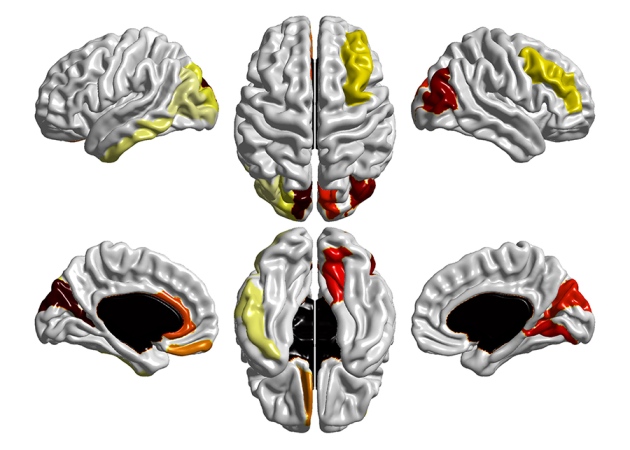Detecting Autism in Babies
Page 1 of 1 [ 2 posts ]
Campin_Cat
Veteran

Joined: 6 May 2014
Age: 62
Gender: Female
Posts: 25,953
Location: Baltimore, Maryland, U.S.A.
http://www.nature.com/news/brain-scans-spot-early-signs-of-autism-in-high-risk-babies-1.21484
Nature wrote:
By scanning the brains of babies whose siblings have autism, researchers say they have been able to make reasonably accurate forecasts about which of these high-risk infants will later develop autism themselves. The findings raise the prospect of diagnosing autism spectrum disorder (ASD) months before children develop symptoms, a goal that has proved elusive. Nature looks at the new study and its implications.
...
What did their latest study look at?
Autism occurs in roughly 1 in 100 children in the general population, but infants with an older sibling with a diagnosis have about a 1 in 5 chance of developing ASD. As part of the US National Institutes of Health (NIH)-funded Infant Brain Imaging Study (IBIS), Piven and Hazlett’s team scanned the brains of 106 of these ‘high-risk’ infants at age 6, 12 and 24 months using magnetic resonance imaging (MRI), to see if they could catch the brain overgrowth in the act. They also followed 42 low-risk infants.
What did they find?
Fifteen of the high-risk infants were diagnosed with autism at 24 months. MRI scans revealed that the volume of these infants’ brains grew faster between 12 and 24 months, compared with children who were not diagnosed with ASD, and that this accelerated growth occurred at the same time that behavioural signs of autism appeared.
The researchers also found brain changes between 6 and 12 months, before ASD symptoms appeared. The cortical surface area — a measure of the size of folds on the outside of the brain — grew faster in infants later diagnosed with autism, compared with those who did not receive a diagnosis.
Could these brain changes be used to predict autism diagnosis in infants?
Hazlett and Piven’s team then used a deep-learning neural network, a form of machine learning, to ask if MRI scans at 6 and 12 months in a larger set of high-risk infants could predict an autism diagnosis at age 2. The algorithm correctly predicted 30 out of the 37 autism diagnoses (81%), while producing false-positives in 4 out of the 142 infants who were not later diagnosed.
“We now have this finding in these high familial risk infants that we can predict 8 out of 10 that we think will get autism,” says Piven, adding that behaviour-based predictions do no better than 50–50 at that age. “This has tremendous clinical implications.”
...
What did their latest study look at?
Autism occurs in roughly 1 in 100 children in the general population, but infants with an older sibling with a diagnosis have about a 1 in 5 chance of developing ASD. As part of the US National Institutes of Health (NIH)-funded Infant Brain Imaging Study (IBIS), Piven and Hazlett’s team scanned the brains of 106 of these ‘high-risk’ infants at age 6, 12 and 24 months using magnetic resonance imaging (MRI), to see if they could catch the brain overgrowth in the act. They also followed 42 low-risk infants.
What did they find?
Fifteen of the high-risk infants were diagnosed with autism at 24 months. MRI scans revealed that the volume of these infants’ brains grew faster between 12 and 24 months, compared with children who were not diagnosed with ASD, and that this accelerated growth occurred at the same time that behavioural signs of autism appeared.
The researchers also found brain changes between 6 and 12 months, before ASD symptoms appeared. The cortical surface area — a measure of the size of folds on the outside of the brain — grew faster in infants later diagnosed with autism, compared with those who did not receive a diagnosis.
Could these brain changes be used to predict autism diagnosis in infants?
Hazlett and Piven’s team then used a deep-learning neural network, a form of machine learning, to ask if MRI scans at 6 and 12 months in a larger set of high-risk infants could predict an autism diagnosis at age 2. The algorithm correctly predicted 30 out of the 37 autism diagnoses (81%), while producing false-positives in 4 out of the 142 infants who were not later diagnosed.
“We now have this finding in these high familial risk infants that we can predict 8 out of 10 that we think will get autism,” says Piven, adding that behaviour-based predictions do no better than 50–50 at that age. “This has tremendous clinical implications.”

Coloured regions indicate areas of the cortex that grew significantly faster in infants who were later diagnosed with autism.
ASPartOfMe
Veteran

Joined: 25 Aug 2013
Age: 66
Gender: Male
Posts: 34,473
Location: Long Island, New York
The earlier they kind find out things by brain scanning the faster they can change or alter you.
_________________
Professionally Identified and joined WP August 26, 2013
DSM 5: Autism Spectrum Disorder, DSM IV: Aspergers Moderate Severity
It is Autism Acceptance Month
“My autism is not a superpower. It also isn’t some kind of god-forsaken, endless fountain of suffering inflicted on my family. It’s just part of who I am as a person”. - Sara Luterman
Page 1 of 1 [ 2 posts ]
| Similar Topics | |
|---|---|
| How Many Alien Babies Have You Had? |
05 Feb 2024, 10:42 pm |
| Autism |
13 Mar 2024, 7:44 am |
| Different types of autism? |
06 Apr 2024, 10:22 am |
| Autism and therapy |
04 Apr 2024, 6:32 pm |





